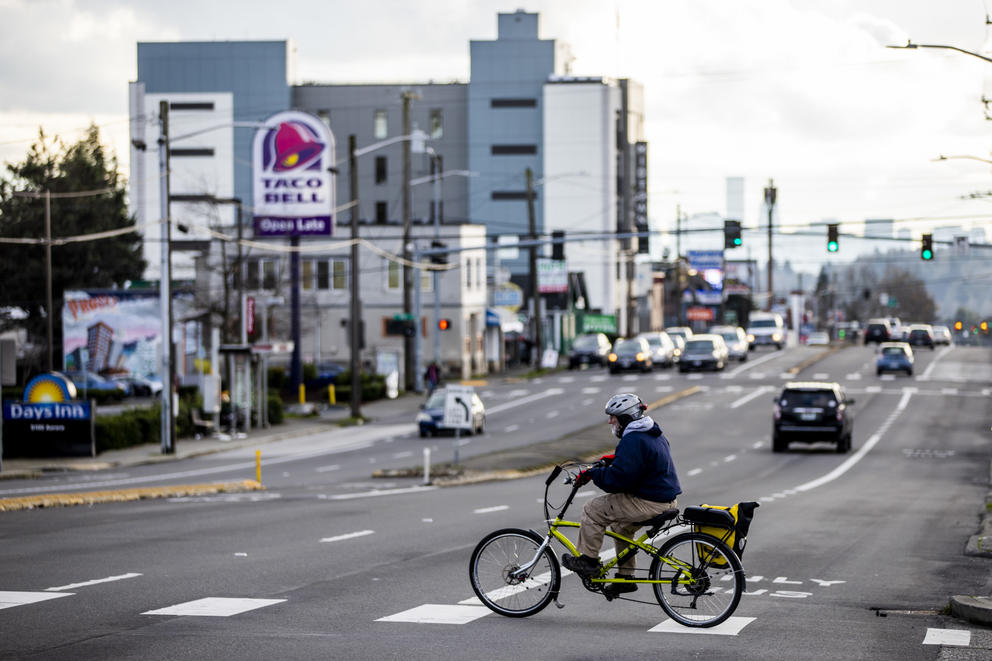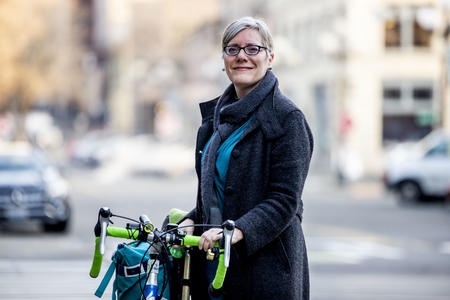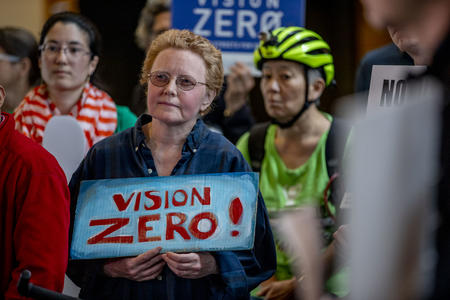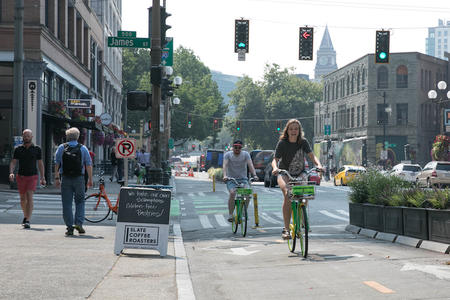In a draft plan published in December that updates a 2008 plan, however, WSDOT took a new approach that meets growing demand for safe, low-carbon transportation: It looked at whether state roads were suitable for active transportation modes like walking and biking — and even growing modes like scootering — based on where people want to walk and bike, but don’t.
“I believe that it’s going to be a significant step forward for the state of Washington and for the work that we're doing,” says Scott Waller, the bicycle and pedestrian program manager of the Washington Traffic Safety Commission, of the draft plan. “It’s a relatively recent conversation [in Washington state] to talk about walkers and rollers as being people you need to plan for.”
But the analysis also revealed that a $5.7 billion investment is needed to get there.
“If we'd been reporting [these needs] all along, the numbers would feel different,” says Barb Chamberlain, director of active transportation with the state since 2018, noting the costs aren’t fixed.
As the state trends away from goals for Target Zero — a program meant to eliminate traffic deaths in Washington by 2030, similar to the international Vision Zero program — and the pandemic and climate change emphasize the value of active transportation, making these investments swiftly may be necessary for the health of all Washingtonians.
“Clearly, the existing strategies aren't working,” says Anna Zivarts of Disability Rights Washington. Between the two most recent three-year periods of evaluating traffic deaths and injuries, the state saw a 23% increase in fatalities and a 7% increase in injuries. “We need new and potentially radical new approaches if we are going to decrease these deaths and serious injuries,” Zivarts says.
WSDOT calculated that the 110 pedestrian and bicycle fatal crashes and 464 serious injury crashes that happened in 2019 in our state had a societal value of $1.965 billion — that is, people would have been willing to pay $1.965 billion to avoid them. A recent cost-benefit study of the bike infrastructure found that in Seattle, fatal crashes dropped by 60.6% over a 13-year period after more bike infrastructure was added.
“People are willing to pay more to save lives, which is the context for looking at an entire system analysis,” Chamberlain says.
The state is conducting three remote public webinars with overviews of the plan, the first of which took place Jan. 13, and is allowing public comment through 5 p.m. Feb.15.
Investing in infrastructure for people biking, walking, scooting, using wheelchairs and more enhances alternatives to driving. That, the draft report shows, presents a cheaper way to reduce traffic congestion than highway widening, while also increasing opportunities for safe forms of fitness and mobility and benefiting the climate.
“If we could get 5% of the people who are taking short trips on Interstate 5 — so five miles or less — onto a bicycle, we could basically almost eliminate traffic jams,” Waller says. “That would be a huge deal,” not only for traffic congestion, but also for people suffering from pollution along I-5.
Washington already has a proof-of-concept with the 520 Bridge Trail, a 2.7-mile separate pathway along State Route 520 connecting Seattle and the Eastside. After it opened in 2017, more people started biking on the route.
“Many studies have shown that adding highway capacity does not solve gridlock. It induces more demand and the gridlock quickly returns,” says lawyer Bob Anderton of Washington Bike Law, whose clients rely on active transportation. “Mode change is what we need, but that won’t happen when gas is cheap, parking is free and roads are dangerous for people outside of cars.”
The draft plan evaluated 6,977 miles of state highway, where 27% of all fatal and serious traffic injuries involving bike and pedestrian traffic occurred between 2010 and 2019. While state roadways weren’t originally intended to support active transportation, many of them intersect with and impact the city roads where the majority of deaths happen, and development means that growth has happened around state routes.
About 180 miles of state roads are off-limits to cyclists and more than 1,100 miles prohibit pedestrians. There are only 127 miles of bike lanes on state highways, compared with 1,700 miles of state roadway that runs through population centers. Even the roadways that allow cyclists don’t offer the services necessary to meet safety minimums: 2,700 of the approximately 7,000 miles of bike-accessible roadway do not have shoulders measuring at least 4 feet wide, a problem that becomes more noticeable as speed limits increase. WSDOT manages approximately 38 miles of paved trail, though there are more facilities managed by WSDOT partners on WSDOT right-of-way.
Making active transportation accessible, enticing, and safe
The draft provides Washington a rationale for including active transportation as part of a truly statewide continuous network, assessing what’s needed to make biking, walking and rolling a possible key way to reduce traffic stress wherever state streets are. The first part of the two-part document looks at the quality, equitability and desire for current infrastructure.
The proactive, whole-network approach marks a fundamental change in how the state evaluates safety needs and funding, which previously had been analyzed on a project- or corridor-specific basis.
“We get spot requests and have some funding to do a responsive or reactive fix. But absolutely what none of those have ever done is say, if you were trying to get somewhere by active transportation, can you get all the way there?” Chamberlain says. “Whatever budget we have, as we look at any place [identified for spot treatment], we can now be more aware of the role that that location plays in the overall network.”
“We know people will walk and bike more when there is a connected network and the infrastructure feels safe, and easily accessible and intuitive,” says Alex Alston, state policy director of Washington Bikes.
Active transportation investments often rely on vulnerable cyclists and walkers to provide evidence of above-average demand or safety concerns at specific locations, but the draft plan removes that burden. Rather, it identifies both places where people would like to safely travel between but currently don’t (because of safety concerns or because facilities don’t yet exist) and spots where data indicates potential crash exposure rather than waiting for people to be killed or injured before fixing safety problems. “You don’t have to count the number of people swimming across the river to justify building a bridge,” the authors write.
To do this, researchers evaluated all state road systems for Level of Traffic Stress (LTS) — effectively, on a scale of 1 to 4, how aware a cyclist or pedestrian needs to be to use a road safely for urban and rural areas. They also looked at how inconvenient state roads are.
Ultimately, the roads most in need of change are those without sidewalks and bike lanes and where driving speeds are greater than 30 mph; the draft authors note 86% of pedestrian and road deaths happen on streets with speed limits of 30 mph or more, and only about 6% of state roadway miles in population centers have posted speeds of 25 mph or less.
The increasing burdens of death and injury are felt disproprotionately by communities that are historically underfunded. Thirty-three percent of fatal and serious traffic injuries involving cyclists and pedestrians in Washington occurred in census blocks with greater than average Black, Indigenous and people of color populations, even though those blocks represent only 24% of the population.
“I think the crash data and what we see for serious injuries and fatalities do match up with places where there's been underinvestment, where you'll find communities of color and low-income communities,” says Alston of Washington Bikes. She says she’ll use this analysis to push for increased funding in more strategic ways. Projects like the Safe Routes to School and Pedestrian & Bicycle grant programs are effective and in high demand, she says, but “there's still a lot more work to do on these state routes and we've not been able to do that in a way that addresses the greatest need.”
What needs to happen?
This plan does not offer specific fixes for specific locations across the entire state. It does, however, outline the types of fixes that could lower stress on all state routes in population centers and create a connected regional trail system.
There are plenty of variables involved with traffic deaths outside the realm of this report, like vehicle design, which Washington Bike Law’s Anderton points to as a leading cause of the increase in bike and pedestrian injuries. “Motor vehicles have gotten safer and safer for people inside of them [thanks to things like air bags and crumple zones], but they are more and more dangerous for people outside of them.”
What WSDOT can do is encourage protection from vehicles and the people who drive them.
Common solutions include reducing vehicle speed; separating cyclists and pedestrians from drivers, especially where cars travel faster than them; increasing the number of safe street crossings; and adjusting bridges for improved active transportation.
Chamberlain believes crossings are the most important thing to address: At least 60% of pedestrian deaths happen at crossings. She thinks we need more crossings, and that current ones can be improved with better road markings, signage and lighting to cue drivers to stop. Next on her list is slowing traffic down. “We have state routes that were built to be places for driving fast, but now they are functioning like city streets,” she says.
But speed limits can be broken: She says physical barriers to speeding, like traffic gardens, are essential.
The Washington Traffic Safety Commission’s Waller adds that doing things that prioritize cyclists and walkers — giving them headstarts on street crossings, for instance — are minor inconveniences that significantly reduce crashes. “These are kind of low-hanging fruit … that are certainly a heck of a lot cheaper than trying to lay down another lane on I-5,” Waller says.
Too little, too late?
Ryan Packer, temporary editor of Seattle Bike Blog, says the state isn’t keeping up with needed investments to achieve Target Zero, or support climate goals, or reflect possible new normals during the COVID-19 pandemic.
“The state is trying to encourage people to walk and bike, and yet prioritizes the expansion of state highways over making investments in the highways that it has already built to ensure that they are safe to use,” says Packer, pointing to places like Highway 526 in Everett.
“Considering the backlog of road and bridge maintenance, the salmon culverts, the gaps in ped and bike networks caused by WSDOT roads and the detrimental public and environmental health impacts of increased driving, we absolutely should not be considering funding road widening or new construction,” adds Zivarts of Disability Rights Washington.
Proposed investments for the next two years still leave much to be desired for active transportation, Packer says. “The active transportation plan says we could add speed treatments to every single mile of the state system through population centers that need it for only $283 million. For another $165 million, we can improve safety at over 1,300 highway ramps where safety is currently lacking. This total is less than many single interchange projects built in Washington in the last decade,” Packer says, referencing infrastructure that guides traffic where roads meet freeways, or freeways meet freeways. A single recent interchange project in Lacey, designed to help with congestion, was funded for nearly $46 million. A single recent interchange project at I-405 and SR 167 was recently funded for $196 million.
But there’s still a lot of room for growth, for one because the draft plan came out after the governor’s proposed budget for the next two years.
Even so, Alston says there are good signs in that proposed budget, like a $20 million increase in bike and pedestrian grant programs. With that increase, the proposed budget puts $33.38 million for the Pedestrian & Bicyclist program and $24.15 million for Safe Routes to School.
“I'm also aware, politically, that that dynamic is not going to change for passing a large revenue package like this, and so I don't think this will necessarily be an easy strategy to achieve. But I do think it gives us a different map to follow,” Alston says.
But the money and infrastructure to support active transport will ultimately require a culture that prioritizes biking and walking over driving. Safety might be the rallying point.
“There's an expectation from drivers that you should be able to get in your car and get someplace really, really, really quickly without interruption,” Waller says. “Cultural belief is going to need to change a bit. People are going to need to be a little bit more tolerant. Drivers are going to have to see that there's an advantage to roundabouts to them, as well as to pedestrians.”






